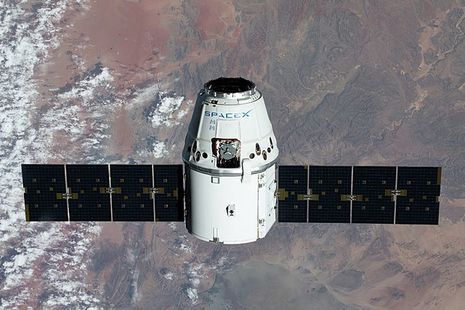It’s only rocket science, Elon
‘Rapid unscheduled disassembly’ – Starship flight 9 ended in a fireball

In the early hours of Wednesday the 28th May, SpaceX’s Starship launched from southern Texas for its ninth test flight. Within an hour of launch, Starship had been reduced to debris, and is currently scattered in the Indian Ocean. The explosion of Flight 9, combined with the recent failures of Flights 7 and 8, now cast doubt on the efficacy of the Starship system and its role in the future of global space exploration.
Starship is composed of two stages, a booster and a rocket, both of which are intended to return to Earth for reuse after each flight. Flights 7 and 8 both saw the booster successfully return to Earth whilst the upper stage rocket exploded. However, during Flight 9, after having separated, both parts of Starship underwent catastrophic failure with the upper stage losing altitude control and the lower stage failing to reorient itself for re-entry and exploding in the atmosphere.
The question arises, after three consecutive failures in almost as many months, will the American FAA continue to approve SpaceX launches? SpaceX struggled to get approval for Flight 9, following difficulties with engineering inspections. Flight 8 in March 2025 scattered debris around Southern Florida and the Caribbean and led to the grounding of scores of flights. SpaceX’s future is assured by two principal advantages. Firstly, Elon Musk’s political standing in the Trump administration made FAA approval almost a formality (before their great schism a month ago). Secondly, NASA is relying on Starship to launch its Gateway station and for the Artemis missions in the late 2020s. Starship remains crucial to the future of American space exploration yet its performance has come into question.
“We choose to go to the moon in this decade”
In 1962, Kennedy said of the space race with the Soviets: “We choose to go to the moon in this decade and do the other things, not because they are easy, but because they are hard”, it was understood that American space exploration would be a large-scale state funded endeavour, undertaken for the good of the US and the wider world. Now, NASA’s budget is only four tenths of a penny from every tax dollar the federal government spends. With this shift towards privatisation and declining public support for investment in space exploration, the heavens may be dominated by Chinese Taikonauts, as the trajectory of the second space race becomes clear.
Despite its recent failures, Starship is among the greatest feats of aerospace engineering of the 21st century. The Starship system is composed of 2 stages: the Super Heavy Booster and the Starship rocket itself. Super Heavy is the heaviest thing to ever fly and broke history last year when it successfully returned to earth and was, as described by Musk, caught vertically with ’chopsticks’. Super Heavy has 33 Raptor Engines and is full of fuel, to help it accelerate Starship out of low earth orbit. Starship and Super Heavy are intended to be fully reusable, but only the latter has ever been successfully returned to Earth. The Starship system is intended to ferry astronauts to the moon within the next 5 years and eventually to Mars.
“Musk’s rapid design iteration has proven successful in the past”
The significance of Starship is highly political. Large budget cuts are being levied against NASA in Trump’s ‘Big Beautiful [spending] Bill.’ Should the proposed cuts be approved, NASA will have to downsize much of its space exploration capability and will be more reliant on SpaceX (whose rockets hopefully won’t explode). NASA has already built Gateway, a space station intended to orbit the moon (akin to the ISS for Earth) in order to facilitate easy lunar landings and prolonged lunar exploration. Similarly, the Nancy Grace Roman Space Telescope, designed for deep space exploration and dark energy monitoring, is sitting in a garage in Maryland. NASA will need Starship to launch both of these vehicles and to facilitate the Artemis missions over the next decade. Artemis, like her twin brother Apollo, will see mankind return to the moon.
“Launch Cadence for the next three flights will be faster”, Elon Musk stated, following the explosion of Flight 9. Musk’s approach of rapid design iteration has proven successful in the past but this recent failure was undoubtedly a significant setback.
The initial plan was that, following a successful launch, Musk would deliver a speech on the future of Mars exploration. This announcement was postponed indefinitely and SpaceX are waiting to actualize their current goals, before telling us what comes next. One can’t help but doubt the modern American model of hybrid private and state-funded space exploration. Can NASA, along with its cabal of billionaire-backed contractors, hope to mirror the successes of the 20th century? Can they compete with the other superpowers? SpaceX and NASA are going to have to work fast if they want to return to the moon before the Chinese National Space Administration, who intend to have men on the moon by 2030. This deadline suddenly seems feasible in comparison to the plan to launch for Mars, before the current launch window closes in 2026.
 News / SU stops offering student discounts8 January 2026
News / SU stops offering student discounts8 January 2026 News / Uni-linked firms rank among Cambridgeshire’s largest7 January 2026
News / Uni-linked firms rank among Cambridgeshire’s largest7 January 2026 Comment / Plastic pubs: the problem with Cambridge alehouses 5 January 2026
Comment / Plastic pubs: the problem with Cambridge alehouses 5 January 2026 News / New movement ‘Cambridge is Chopped’ launched to fight against hate crime7 January 2026
News / New movement ‘Cambridge is Chopped’ launched to fight against hate crime7 January 2026 Comment / What happened to men at Cambridge?31 December 2025
Comment / What happened to men at Cambridge?31 December 2025










